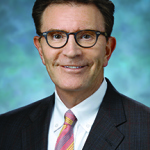A Paradigm Shift for the Field
To ensure the viability of our profession, the business case for sleep medicine needs to be strengthened. To grow the field, we need to demonstrate that sleep treatments are cost effective and produce quantifiable financial results. In the new modern medicine, health care dollars will increasingly be allocated based on demonstrated return on investment. This is a radical paradigm shift for most clinicians and researchers in the sleep medicine field.
In this second article in the series on sleep and corporate health, we’ll delve deeper into the corporate perspective on health care, with an eye toward sleep. To advance the discussion, I invited my colleague, Edward J. Bernacki, MD, to a wide-ranging conversation regarding medicine in a corporate context, and how value is perceived outside the sleep medicine world. Some of our dialogue is included below.
A Conversation with Dr. Ed Bernacki

Dr. Emerson Wickwire: You’ve worked with some major multinational corporations like PepsiCo, Nestle, and Hughes Electronics. What kind of results have your clients achieved?
Dr. Ed Bernacki: The biggest reason employers use our service is to reduce direct healthcare costs – the treatment costs for work-related injuries and illnesses, and of course, all the ancillary testing that goes along with employment, pre-placement drug testing, and so forth. Anytime you have a labor-intensive workforce, then salaries make up a huge portion of the cost of the final product. And medical care costs are about 8-9% of the total salary compensation. So even a small medical care cost saving can have a huge impact on the bottom line.
EW: By definition, corporate health care delivery takes place within a primary business context. So although our objectives as health care providers don’t change, the value-add of our services can vary widely depending on the business environment. In many industries, salaries account for 50% or more of operating expenses. So in a large corporation, this could easily be hundreds of millions or even billions of dollars.
EB: If you have enough employees, in the end it’s cheaper to buy healthcare in volume from a provider like us. Usually in a manufacturing environment, 400 employees or more, will justify the provision of onsite medical care in a cost effective manner. In an environment where the profit per employee is extremely high, the avoidance of direct medical care costs is not necessary to make a case for the provision of onsite medical care. Here keeping employees at work and increasing productivity usually justifies an onsite clinic at the workplace.
EW: Speaking of what matters to business, how aware are you clients on the importance of sleep? In my experience, outside of fatigue risk management, corporate sleep initiatives are in their infancy.

EW: I think you hit the nail on the head. Unless sleep impacts a core business such as interstate commercial driving, or unless there is a regulatory requirement, sleep isn’t yet on executive radar. The sleep field has not done a very good job making a business case for sleep medicine care.
EB: I don’t think there’s enough information around for employers to make cost benefit decisions on the effect of sleeplessness on their populations except for a few industries like trucking. More outcomes research is needed to demonstrate the short and long term benefits of diagnosing and treating sleep disorders. It is understandable that companies would like to have an immediate payoff for an investment in improved sleep. The field needs to put a number on it, to say it’s going to $3,000 in a given policy year, yet return is going to be $8,000 or $9,000 per employee with the disorder. If this were available, I would tell you employers would flock to assessing sleep disorders. Quantification is very important. Most employers are business people. They’re used to dollars and cents and quantifying performance.
EW: Most sleep medicine professionals simply want to know does the treatment work? We need to ask, is it worth it? And as you know, this is work in which we at Maryland and others are actively engaged. Let’s shift gears a bit and talk about wellness and prevention.
EB: Wellness is gaining traction in American business. But for me, it’s very hard to wrap my brain about the cost effectiveness of the various types of wellness offerings. Because of the high turnover rate in most industries it may not make sense in a weight management program for younger workforce. However, in an older workforce diabetes detection and disease management programs can easily be justified regardless of the turnover. There is an immediate gain in healthcare costs if individuals with chronic diseases are identified and the condition is controlled.
EW: It’s a very different play than chronic disease management, where the cost savings are so easy to identify.
EB: The chronic disease management programs go to the bottom line very quickly. Hypertension control, diabetes, all those, conditions with which we’re familiar. This is a medical model, as opposed to a primary and secondary prevention model.
EW: From a motivational and behavioral perspective, engagement and adherence are primary drivers in both preventative, as well as chronic disease models. But too often, patients don’t get the support they need.
EB: It doesn’t make sense to not manage these patients well – that’s what we’re all about. We do that. It’s the same thing with people with chronic diseases in the workforce. We need to identify these folks and follow them very closely. Of course we’re in a great position to do that because we’re right at the work site. We’re there everyday.
EW: In a closed system, corporate or otherwise, you have the ability to control the system end to end – screening, triage, assessment, all the way through long-term management – and adhering to a very tight protocol. I envy your ability to leverage technology. It would surprise most practitioners. Let’s wrap up by considering the human side, if you will, of healthcare in corporate settings. Too many medical folks are skeptical of occupational or corporate anything.
EB: Never, never lose sight that for most employers, the employees are their friends, they work with them and they want to see them healthy. If it’s not going to cost any more, then employers want to do the right thing for their employees. They’re looking for justification to implement a preventive strategy and want to make life better for their employees.
EW: This reflects that your clients are good people, too. The belief among clinicians is so often that somehow the dollars and cents are all that matters to corporate interests. You just beautifully debunked that.
EB: It’s so true. Most employers, the vast majority of employers really are very concerned about their employees. They are employees, too. The shareholders may own the corporation, but we all work at them. We want to take care of each other.
EW: Dr. Bernacki, thank you for an excellent discussion. As always, it’s been a pleasure. I’m sure our readers have enjoyed listening in.
Three Actionable Recommendations
In every challenge, there lies an even greater opportunity. As a field, our opportunity is to demonstrate our value – which we know exists – in ways that matter to external stakeholders. To accomplish this, it will be necessary to adopt the perspectives of the end users of our services. We need to speak to their interests, in language they understand.
For the betterment of our field and so that we can continue to benefit future populations, embrace these three suggestions:
- Leaders in sleep medicine should learn and share what cost-effectiveness information is already available. In sleep, there is plenty that is known – more than twenty published cost-effectiveness studies. Start with a simple articles like this.
- Academic and industry researchers should evaluate and report economic endpoints in every clinical trial. This will not only advance scientific understanding but also increase awareness among clinicians and consumers of scientific research.
- Sleep medicine educators at all levels should incorporate an introduction to health economic issues. Too many are presently unable to speak articulately regarding financial aspects of sleep medicine care.
The future of sleep medicine is bright, and the need for sleep expertise has never been greater. Healthy sleep improves lives. But expanding our reach and increasing our impact will require a paradigm shift. To maximize our value, we need first to understand the perspectives of our business counterparts. Only then, with their values in mind, can we deliver the full promise of sleep.
Tune in for the final installment of Dr. Wickwire’s series on sleep and corporate health – we’ll explore the exciting and largely untapped area of sleep and executive leadership.
A version of this article originally appeared in Sleep Review.